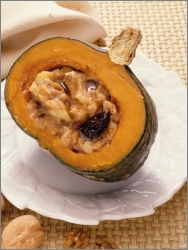Winter Squash: Four Major Reasons Why
You May Want to Eat More of This Autumn Favorite
by www.SixWise.com
Squash have been part of the human diet for more than 10,000 years, and it was Christopher Columbus who brought the sweet-fleshed food back to Europe from the New World. Before that, Native Americans would bury squash along with the dead so they would have nourishment on their final journey.
|

Squash look beautiful as a fall centerpiece, but why not try them as a main course instead?
|
In the United States, winter squash makes its debut around August, but they're in season from October to November, making them a fall-time favorite. Some varieties include:
-
Butternut squash: This large, pear-shaped squash is cream-colored outside with sweet orange flesh inside.
-
Acorn squash: Outside acorn squash is green with orange patches, but the inside is yellow with a sweet, nutty and peppery flavor.
-
Hubbard squash: This large, less-sweet squash can be dark green, grey-blue or orange-red in color.
-
Turban squash: Outside this squash is green with stripes or speckles, inside it's orange-yellow with a flavor similar to hazelnuts.
-
Pumpkins: For eating purposes small pumpkin varieties, such as sugar or pie, have the most flesh and the sweetest flavor.
-
Spaghetti squash: This yellow-colored squash has sweet, slightly nutty flesh that separates into strands like spaghetti when it's cooked.
Antioxidants Galore and Other Healthy Reasons to Eat Winter Squash
Squash maintains a low profile compared to other superfoods like garlic, broccoli and blueberries, but it actually packs a powerful nutritional punch. Winter squash is rich in vitamin A (in the form of beta-carotene), vitamin C, potassium, dietary fiber, manganese, folate, omega-3 fatty acids, vitamin B1, copper, vitamin B6, niacin-vitamin B3 and pantothenic acid.
Beta-carotene, which is one of the most abundant nutrients in winter squash, has powerful antioxidant and anti-inflammatory properties that can prevent the oxidation of cholesterol in your body. Oxidized cholesterol contributes to the risk of heart attack and stroke, so eating winter squash may help protect your heart health. Further, winter squash:
-
Has Anti-Cancer Effects: Vegetable juices from squash rival juice from leeks, pumpkin and radish in their ability to prevent cell mutations (which could lead to cancer).
-
Promotes Men's Health: Squash extracts have been found to help reduce the symptoms of benign prostatic hypertrophy (BPH) in men, which occurs when the prostate gland becomes enlarged.
|

Orange fruits and vegetables are among the most highly recommended foods for your health because they contain healthy, naturally occurring pigments called carotenoids.
|
-
Supports Lung Health: Squash contains beta-cryptoxanthin, a carotenoid that may lower your risk of developing lung cancer. In fact, a study in Cancer Epidemiology, Biomarkers and Prevention found that those eating the most crytpoxanthin-rich foods showed a 27% reduction in lung cancer risk. Smokers who ate a lot of crytpoxanthin-rich foods were particularly impacted, having a 37% lower risk of lung cancer compared to smokers who ate the least.
-
Supports Colon Health: Winter squash contains folate, a nutrient that not only helps to prevent birth defects if taken during pregnancy, but also helps break down homocysteine, a toxic metabolic byproduct that can damage blood vessel walls. Folate also helps protect colon cells from cancer-causing chemicals, and diets that include a lot of folate-rich food like winter squash are linked to a reduced risk of colon cancer, particularly in people who drink alcohol.
Easy Ways to Cook and Enjoy Winter Squash
Don't be turned off to squash because of its hard, cumbersome exterior. Preparing most squash is as simple as washing it off, cutting it in half, removing the seeds and peeling (although some recipes don't even call for peeling).
You can even bypass all preparation and simply pierce the squash near the stem, then pop it into a 350 degree F oven for 45 minutes to one hour (until the squash is tender). If you want something a little more elaborate, try out the delicious recipes below.
Spaghetti Squash with Jalapeno Cream
Ingredients
- 1 spaghetti squash (about 3 lbs.)
- 2 cups milk
- 2 to 3 jalapeños, stemmed, seeded, and chopped
- 2 tablespoons butter, plus more for pans
- 3 tablespoons flour
- 1 teaspoon salt
- 1 cup shredded jack cheese
Preparation
-
Preheat oven to 375°. Cut squash in half lengthwise and use a spoon or melon baller to remove seeds and surrounding fiber. Put squash, cut side down, on a lightly buttered baking sheet and bake until tender when flesh is pierced with a fork, 30 to 40 minutes. Or poke several holes in skin of squash with a fork and microwave it on high 10 minutes. Squash should be tender when pierced with a fork; if it isn't, microwave on high in 1-minute intervals until tender. Let sit until cool.
-
Meanwhile, in a medium saucepan over medium heat, warm milk and jalapeños until bubbles form along the edge of the pan. Remove mixture from heat and let sit 15 minutes. Strain and discard jalapeños.
-
When squash is cool enough to handle, use a large spoon to scrape the strands out of the skin and into a large bowl.
-
In a medium saucepan over medium-high heat, melt 2 tbsp. butter. Whisk in flour and salt and cook, whisking, until flour smells cooked (like piecrust), about 3 minutes. Slowly pour in jalapeño-infused milk while whisking. Reduce heat to medium and continue whisking until mixture thickens slightly, about 3 minutes. Pour mixture over squash and stir to combine. Transfer mixture to a buttered 2-qt. baking dish. Sprinkle with jack cheese and bake until bubbling and brown on top, about 30 minutes.
Recipe Source: MyRecipes.com
Butternut Squash with Green Chile and Mustard Seeds
Ingredients
- 2 teaspoons vegetable oil
- 1/2 teaspoon brown mustard seeds
- 3 garlic cloves, finely chopped
- 1 serrano chile, halved, seeded, and thinly sliced
- 1 medium butternut squash (about 2 lbs.), peeled, seeded, and cut into 1-in. cubes
- Salt
- Chopped cilantro (optional)
Preparation
-
Pour oil and mustard seeds into a large frying pan. Cook over medium-high heat, covered, until seeds finish popping, about 1 minute. Add garlic and chile and cook, stirring, until garlic just starts to brown, about 1 minute.
-
Add squash and stir to coat. Add 1/2 cup water, cover, and cook until squash is tender to the bite, 20 to 25 minutes. Sprinkle with salt to taste and garnish with cilantro if you like.
Recipe Source: MyRecipes.com
Recommended Reading
The Turnip: Nutrition, Uses and Some Interesting Lore of "One of the Most Important Vegetables"
Pumpkins Aren't Just for Scary Faces: Pumpkin Nutrition, Uses, Recipe ... and Some Interesting Lore
Sources
World's Healthiest Foods: Squash, Winter